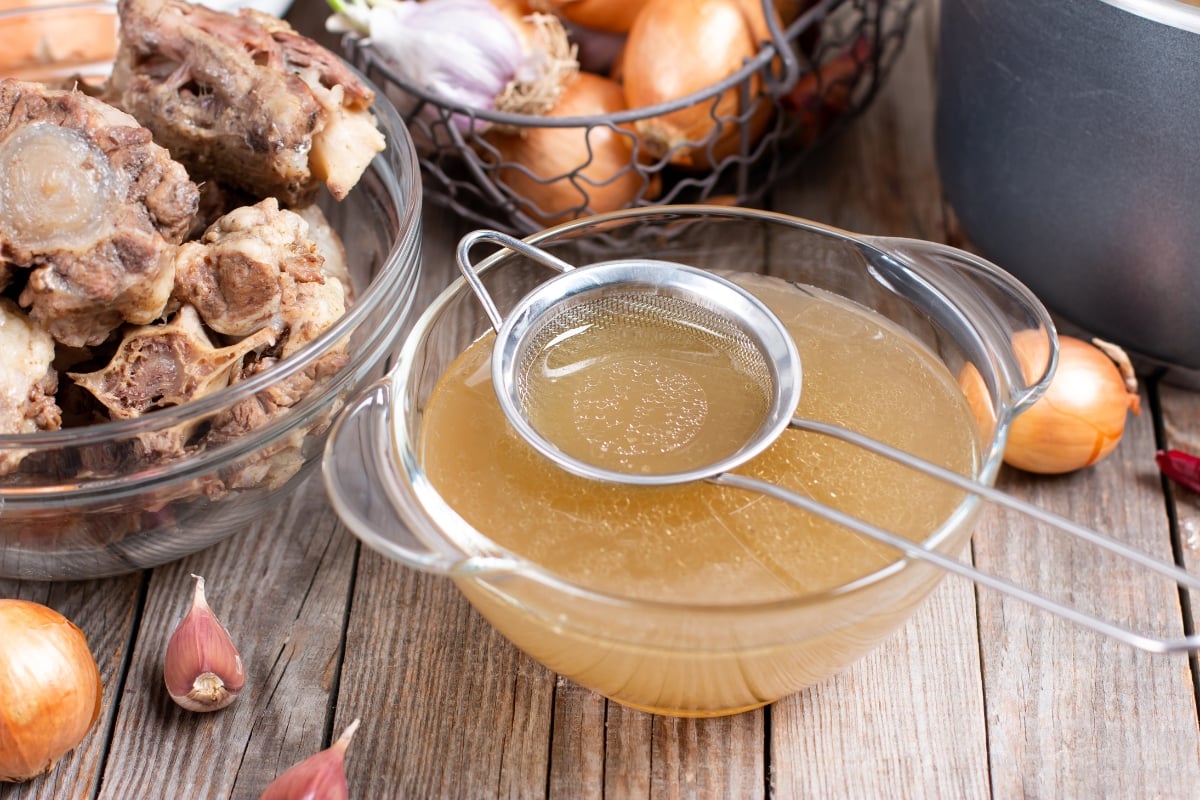Are you striving to build a resilient household? Learning to make bone broth is a valuable skill that can enhance your family’s preparedness. This article will guide you through the process of creating a nutrient-packed, cost-effective food source from what would otherwise be discarded.

Some of the links in this post may contain affiliate links for your convenience. As an Amazon Associate, I may earn a small commission from qualifying purchases without any increase in price to you.
One of my favorite meals growing up was my mom’s turkey noodle soup, made from the little bits of meat and bones of our leftover Thanksgiving turkey. My mom would make a huge pot of it every year, which we would then keep in the fridge until someone felt a little peckish. The broth would set up like Jell-O, so if we wanted some we’d have to gouge out a portion with a measuring cup; it would melt into a liquid in the microwave.
Her secret? Boiling the turkey bones the way she did, created bone broth. She didn’t know it at the time, but she was a trend-setter before bone broth was a trend! They say that if the broth becomes a solid upon refrigeration, you’re doing it right. And she created perfect bone broth every time. Objectively, I can see how perhaps this description would seem unappetizing to some, and that is unfortunate because soup broth had a rich, delicious flavor that could not be rivaled by lowly bullion cubes.
How to Make Bone Broth
Bone broth is economical, flavorful, nutritious, and on top of all that is a good way to use the little tiny scraps and bits of protein that can be found on bones. Bone broth at its most basic can be made in three steps:
Step One: Obtain soup bones
Soup bones are extremely inexpensive and can be found at any regular grocery store. Usually these will be labeled “soup bones” and can be found in large quantities for as little as one dollar. Oxtails and sections of beef shank are slightly more expensive but also make excellent bone broth. Bones from fish or poultry are equally effective.
Alternately, just keep any bones from your everday cooking. I keep bones in a zip-loc bag in the freezer until I’m ready to make a large batch of broth. If you get your meat from farmers, be sure to ask for any bones they might otherwise discard.
Step Two: Boil the bones
There is some debate as to how long you should boil your bones. Some say 2-3 hours is sufficient, while others claim that you should leave it to simmer overnight or as long as a full 24 hours. Many suggest roasting beef bones first for optimal flavor, but I have been known to skip this step and still be pleased with the result. You can also add vegetables to your bones during the cooking process, and this does improve the flavor. Aromatic vegetables like celery and onions and herbs are popular additions, as are carrots.
Boil and boil. Boil those things into oblivion. This can take up to several hours. The process can be expedited by using a pressure cooker instead of a regular stock pot (more on that later). This process gets all the nutrition that can be had out of the bone (bits of fat, protein, collagen, etc.) and into the broth.
Step Three: Strain out the solids
Because, you know, you couldn’t actually want to eat the bone. (While crunchy, the bones would most likely do a number on your teeth, apart from being a possible choking hazard.) If you used the carcass of your Thanksgiving turkey or the leftovers of a roast chicken, you’ll find lots of teeny little bones and bits of gristle that you’d rather not find in your soup. Any solids remaining from vegetables can be discarded, as after an intense boil all of the nutrients have gone out of them and into the broth.
Printable Bone Broth Recipe

Bone Broth
Making bone broth is a straightforward process that can be adapted to various cooking methods and preferences.
- Soup bones Beef, chicken, turkey, or fish
- Water
- Vegetables Optional, such as carrots, onions, celery, and herbs
-
Gather Your Bones: Collect bones from roasts, poultry carcasses, or purchase soup bones from the grocery store.
-
Prepare the Bones: For beef bones, roasting can enhance flavor but is optional.
-
Prepare the Bones: For beef bones, roasting can enhance flavor but is optional.
-
Strain: Carefully strain the broth to remove solids.
Cooking Tips
- Pressure Cookers: Using a pressure cooker can significantly reduce cooking time.
- Bone Variety: Combining different types of bones can create a more complex flavor profile.
- Vegetable Additions: Experiment with different vegetables and herbs to customize the flavor.
- Storage: Bone broth can be stored in the refrigerator for a few days or frozen for longer-term storage.
Tips for Making the Best Bone Broth
- Start with high quality bones.
- Low and slow cooking extracts the maximum flavor and nutrients.
- Experiment with different flavors and ingredients.
- Properly store bone broth to maintain its quality.
The Difference Between Stock and Broth
Bone broth has been enjoying a resurgence in popularity in the last little while, but it’s actually been around for a while. Some people refer to it as stock, but according to culinary experts, while stock and broth are related, they are distinct liquids with different characteristics. Functionally, though, they are so similar that I’ll be treating them as though they are the same thing in this article.
The Benefits of Bone Broth
Although not a cure-all, bone broth has been tied to a number of health benefits:
- Nutritional Powerhouse: Bone broth is rich in minerals like calcium, magnesium, and phosphorus, as well as collagen and amino acids.
- Digestive Health: Often touted for its gut-healing properties, bone broth can support digestive function.
- Immune Boost: The amino acids and minerals in bone broth contribute to a strong immune system.
- Joint Health: Collagen, a key component of bone broth, supports joint health and flexibility.
- Economic and Sustainable: Bone broth is an economical way to utilize leftover bones, reducing food waste.
- Emergency Preparedness: Bone broth is one way to stave off nutritional deficiencies or even starvation in an extreme scenario. It’s important to know how to this homemade survival food for that reason alone, although if the power grid has failed and you’re making this over an open fire, just know it will need to be consumed quickly, since refrigeration might not be an option.
- Electrolyte Replenishment: It has enjoyed some popularity as an alternative to sports drinks – the sodium content replaces electrolytes, but without all the sugar that sports drinks are known for.
Getting Your Money’s Worth
In times and places where rationing has been in place, getting good cuts of meat became extremely difficult, if not impossible. If meat was being sold by the pound, it was in the butcher’s best interest to sell you a cut that mostly contained bone. Using the bone for broth meant the money spent on the meat could be used to the fullest extent possible.
Before the 20th century when the vast majority of humans lived in conditions that we moderns would consider abject poverty, using bones in this way became a matter of course. All the more reason to know how to make bone broth in order to maintain a high level of nutrition for your family. During the Great Depression, surely many utilized bone broth, or stock, in their meals, along with the foods on this list.
Cooking Options
Pressure Cooker/Instant Pot
If you don’t already have a pressure cooker, go ahead and get one. Cooking foods under pressure means they are done in less time than if you were to use a conventional pot or pan. From a preparedness standpoint, cooking things more quickly means not only less time, but also less fuel. A regular, run-of-the-mill one with no bells or whistles can be found on amazon for about $45. As with all things, you can also get a super-fancy one for over $100 if you felt so inclined.
An electronic pressure cooker can be powered up by a smaller generator, in a worst case scenario, although, admittedly, it would be worthless in a long-term power failure. A standard pressure cooker can be used on something like a camp stove, but the tricky part would be maintaining the level of heat and pressure throughout the cooking time. This isn’t impossible by any means, but just know that it would be a factor, since the heat from alternative cooking stoves can fluctuate.
A Large Stockpot
Otherwise, a large stock pot filled with water and bones and brought to a boil and then kept at a low simmer for several hours will produce bone broth just fine.
Myths About Bone Broth
Bone broth has become a popular health and wellness trend, but with increased attention often comes misinformation. It’s time to separate fact from fiction. Here are some common misconceptions about bone broth:
- Myth 1: Bone Broth is a Miracle Cure-All. While bone broth offers numerous health benefits, it’s not a magic potion. While it can support overall well-being, it shouldn’t replace a balanced diet or medical treatment.
- Myth 2: All Bone Broths Are Created Equal. The quality of your bone broth depends on several factors, including the type of bones, cooking time, and added ingredients. Store-bought broths may contain additives, while homemade broth offers more control over ingredients.
- Myth 3: Bone Broth Takes Forever to Make. While traditional methods involve long cooking times, modern techniques like pressure cooking can significantly reduce preparation time.
- Myth 4: Bone Broth is Only Good for You When Sick. While bone broth can be beneficial during illness due to its immune-boosting properties, it’s a nutritious food that can be enjoyed year-round as part of a balanced diet.
Frequently Asked Questions
Yes, store-bought soup bones are a convenient option.
Simmering times can vary from a few hours to 24 hours or more.
While generally safe, individuals with specific dietary restrictions or health conditions should consult with a healthcare professional.
Yes, bone broth freezes well.
Related Content About Nutritious Food Storage
Next Steps
Would you like more help putting together your emergency food storage? I created a FREE ebook to help you build a balanced pantry to help you do that! In it I share more simple tips and explanations to help you create an emergency food supply that will provide nutritious and simple meals in an emergency. Get that free build a balanced pantry ebook here.
Final Thoughts
So, there you have it! Bone broth is a versatile and nutritious addition to any kitchen. Whether you’re looking to boost your health, enhance your meals, or build a resilient pantry, bone broth has something to offer. Remember, it’s a simple yet powerful food that can be enjoyed in countless ways. Now, it’s time to roll up your sleeves and start simmering!
















